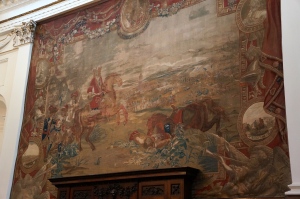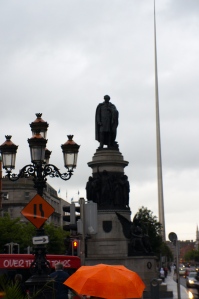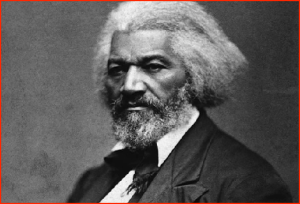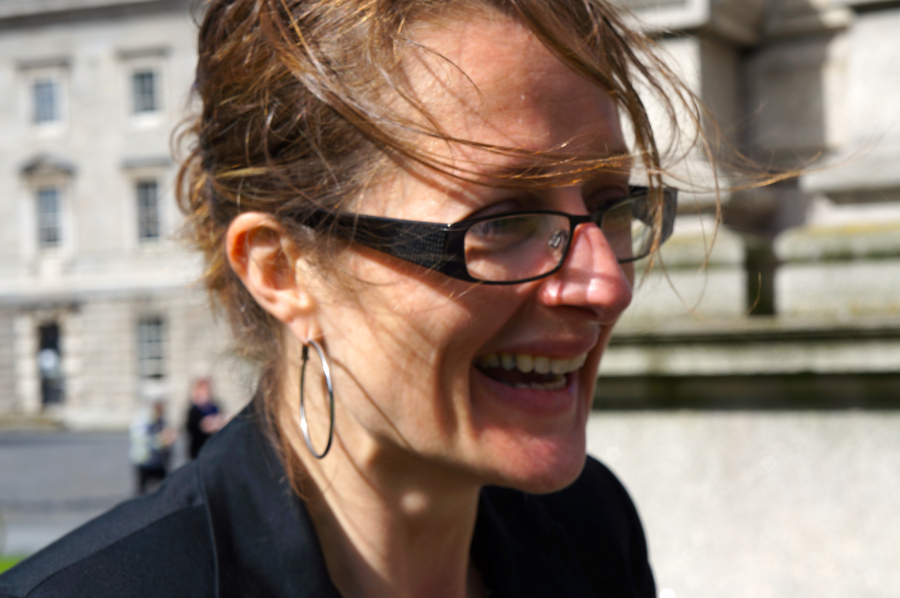To be “sated.”
I always thought “to be sated” meant
to be full to the excess . . .
like that
very much too much
feeling of food and tiredness associated (for me) with Thanksgiving.
When I checked it just now,
I discovered, it can also mean “to satisfy fully.”
I like that.
That’s how we are today,
satisfied fully.
We had a luminous and filling time with our guide, Grace O’Keefe,
 for a walking history tour of Center City Dublin area.
for a walking history tour of Center City Dublin area.
It was just the three of us.
Wow!
Grace is a PhD grad from Trinity College in the Medieval history of Ireland. Actually she got her Masters there, and her undergraduate degree, too. She was born and raised in a small town in Waterford County to the south of Dublin. Her heritage is longish there. Her great grandfather opened a hardware and then her grand father ran it, and finally her father. He retired a few years ago, and couldn’t pass it on . . . well . . . “‘cause of the “big” hardware stores that make the little ones no longer viable financially.”
Actually she got her Masters there, and her undergraduate degree, too. She was born and raised in a small town in Waterford County to the south of Dublin. Her heritage is longish there. Her great grandfather opened a hardware and then her grand father ran it, and finally her father. He retired a few years ago, and couldn’t pass it on . . . well . . . “‘cause of the “big” hardware stores that make the little ones no longer viable financially.”
Grace is a bright, knowledgable, gracious light in Dublin. If you are ever looking for a guide here, Patricia and I would not hesitate to recommend her to you. Let us know and we will provide you the contact information for how to reach her.
Grace “sated” us today with stories about Dublin from the time of the Middle Ages up to now.
She was brilliant!
Among the many times/people of history she talked about was the Battle of Boyne. You might remember that was fought in 1690, and then again you probably don’t.

She talked about the “sated” etiology of this battle on Irish soil that really was about the Brits, not the Irish.
It was a battle about whether James, a Catholic, or his son-in-law, William (William married to James’ daughter, Mary) a Protestant, should be the claimant of the English, Scottish, and Irish thrones.
Oddly, William, the Protestant, had the papal backing, because James, the Catholic (backed by Henry the VIII) was not on speaking terms with the guys in Rome.
You get a wee idea about the complexity of this battle.
It was “sated!”
What I take from Grace’s wisdom is this:
every time we try to simplify
our understanding of . . . well . . . stuff
into the black and white
of, you know,
us versus them,
we err!
Every time!
Life is way more complicated than that.
Life is way more “sated” than that.
Among the many
(as in, “sated”)
other times of Irish history
Grace mentioned to us on our walking tour today
was the time of Daniel O’Connell.
Do you know of him?
The statue of Mr. O’Connell is not much more than a couple hundred yards from where we are staying. 
The process of raising this celebrated monument to the Irish leader Daniel O’Connell took over twenty years in all. O’Connell died in 1847, a subscription was started for his monument in 1862 “when O’Connell was still remembered primarily as the successful liberator of Catholic Ireland”, and the granite foundation stone for it was laid in 1864. Foley was then engaged on the project for the rest of his life, and, sadly, did not live to complete it — although only finishing touches (the statue’s boots, some parts of the clothing on the frieze, and the bodies of the four winged Victories round the plinth) remained to be done. This was one of several important works-in-process to be finished by his assistant Thomas Brock. Benedict Read comments that completing such monumental projects must have stood Brock “in good stead in his subsequent career.’
Above the splendidly winged Victories
 (representing Patriotism, Courage, Eloquence and Fidelity) and below the figure of O’Connell himself is an impressive circular frieze crowded with over thirty figures. In the front centre, the “Maid of Erin” (representing Ireland) points up at O’Connell,
(representing Patriotism, Courage, Eloquence and Fidelity) and below the figure of O’Connell himself is an impressive circular frieze crowded with over thirty figures. In the front centre, the “Maid of Erin” (representing Ireland) points up at O’Connell,  the liberator. The other figures include a bishop with his crosier, a workman with (perhaps) his hoe, a bewigged lawyer and so on, together representing all the elements of Irish society. Since the Victories are partly obscured by traffic lights, and the crowning figure of O’Connell shows the usual effects of exposure to bird-life, this frieze is perhaps is the most striking part of the monument.
the liberator. The other figures include a bishop with his crosier, a workman with (perhaps) his hoe, a bewigged lawyer and so on, together representing all the elements of Irish society. Since the Victories are partly obscured by traffic lights, and the crowning figure of O’Connell shows the usual effects of exposure to bird-life, this frieze is perhaps is the most striking part of the monument.  “It is not a novel design,” writes Christine Casey, of the monument as a whole, but “it is a work of considerable gravitas and virtuosity”; she describes it as “the high point of public sculpture in Dublin.”
“It is not a novel design,” writes Christine Casey, of the monument as a whole, but “it is a work of considerable gravitas and virtuosity”; she describes it as “the high point of public sculpture in Dublin.”
His statue is just across The River Liffey from us tonight.
His statued eyes are looking across the river to us as I write this.
He sees the night-walkers crossing the bridge, of which there are many.
And then, before he looks down the road to us he sees this building:
I googled the “Royal Liver Assurance” and discovered
they sell insurance.
They are
not about dialysis,
they are about insurance.
Such a name, heh?
Daniel O’Connell (born in 1775 and died in 1847) is known of as the “Liberator,” the “Emancipator” of Ireland.
His story is so rich, that I encourage you to google him.
Do you not know of him?
I didn’t, so I am better for this knowledge of our kinship with Ireland.
Ours?
Yes.
Daniel is the emancipator of Ireland whose courage brought to Ireland a a man from the US.
Do you know who, in our USofA history was inspired by O’Connell?
It was Frederick Douglass.
Probably you remember him, but in case you a bit fuzzy about the details, I will put in a portion of his story from Wikipedia:
Abolitionist leader Frederick Douglass was born into slavery in Talbot County, Maryland. He became one of the most famous intellectuals of his time, advising presidents and lecturing to thousands on a range of causes, including women’s rights and Irish home rule. Among Douglass’ writings are several autobiographies eloquently describing his experiences in slavery and his life after the Civil War.
QUOTES
“If there is no struggle there is no progress. . . . Power concedes nothing without a demand. It never did and it never will.”
Frederick Augustus Washington Bailey was born into slavery in Talbot County, Maryland, around 1818. The exact year and date of Douglass’ birth are unknown, though later in life he chose to celebrate it on February 14. Douglass lived with his maternal grandmother, Betty Bailey. At a young age, Douglass was selected in live in the home of the plantation owners, one of whom may have been his father. His mother, an intermittent presence in his life, died when he was around 10.
Frederick Douglass was given to Lucretia Auld, the wife of Thomas Auld, following the death of his master. Lucretia sent Frederick to serve her brother-in-law, Hugh Auld, at his Baltimore home. It was at the Auld home that Frederick Douglass first acquired the skills that would vault him to national celebrity. Defying a ban on teaching slaves to read and write, Hugh Auld’s wife Sophia taught Douglass the alphabet when he was around 12. When Hugh Auld forbade his wife’s lessons, Douglass continued to learn from white children and others in the neighborhood.
It was through reading that Douglass’ ideological opposition to slavery began to take shape. He read newspapers avidly, and sought out political writing and literature as much as possible. In later years, Douglass credited The Columbian Orator with clarifying and defining his views on human rights. Douglass shared his newfound knowledge with other enslaved people. Hired out to William Freeland, he taught other slaves on the plantation to read the New Testament at a weekly church service. Interest was so great that in any week, more than 40 slaves would attend lessons. Although Freeland did not interfere with the lessons, other local slave owners were less understanding. Armed with clubs and stones, they dispersed the congregation permanently.
In 1833, Thomas Auld took Douglass back from his son Hugh following a dispute. Thomas Auld sent Douglass to work for Edward Covey, who had a reputation as a “slave-breaker.” Covey’s constant abuse did nearly break the 16-year-old Douglass psychologically. Eventually, however, Douglass fought back, in a scene rendered powerfully in his first autobiography. After losing a physical confrontation with Douglass, Covey never beat him again.
Frederick Douglass tried to escape from slavery twice before he succeeded. He was assisted in his final attempt by Anna Murray, a free black woman in Baltimore with whom Douglass had fallen in love. On September 3, 1838, Douglass boarded a train to Havre de Grace, Maryland. Anna Murray had provided him with some of her savings and a sailor’s uniform. He carried identification papers obtained from a free black seaman. Douglass made his way to the safe house of abolitionist David Ruggles in New York in less than 24 hours.
Once he had arrived, Douglass sent for Murray to meet him in New York. They married on September 15, 1838. – from, Frederick Douglass.biography
So, here is our connection to Dublin . . .
At the end of 1845, Frederick Douglass traveled to Ireland. He regarded his visit as transformative –  for the first time he felt able to view himself as a man, rather than as the property of another man. The highlight of his time spent in Ireland was meeting Daniel O’Connell, the Irish ‘Liberator.’
for the first time he felt able to view himself as a man, rather than as the property of another man. The highlight of his time spent in Ireland was meeting Daniel O’Connell, the Irish ‘Liberator.’
Today, O’Connell is largely remembered for winning Catholic Emancipation (the right of Catholics to sit in parliament) and for agitating to achieve independence for Ireland. But for Douglass, and thousands of other abolitionists throughout the world, O’Connell was known for his outspoken statements condemning slavery. By 1845, the Irishman was the most influential and outspoken critic of slavery in the world. It was natural that Douglass should want to hear O’Connell speak.
In September 1845, Douglass attended a Repeal meeting in Dublin. He was mesmerized by O’Connell’s lecture, describing it as “powerful in its logic, majestic in its rhetoric, biting in its sarcasm,
melting in its pathos, and burning in its rebukes.” Douglass believed that O’Connell was at his best when he spoke out against slavery, saying “I have heard many speakers within the last four years – speakers of the first order; but I confess, I have never heard one by whom I was more completely captivated than by Mr. O’Connell.”
When speaking in Cork a few weeks later, Douglass again praised O’Connell, telling his audience: “I feel grateful to him, for his voice has made American slavery shake to its center. I am determined wherever I go, and whatever position I may fill, to speak with grateful emotions of Mr. O’Connell’s labors.”
Douglass left Ireland at the beginning of 1846, just as the impact of the potato blight was starting to take effect in the country. His eloquence when lecturing on slavery had earned him the sobriquet ‘The Black O’Connell,’ forever linking him to the Irishman he so admired. Frederick Douglass, 27 years old, a self-educated escaped slave, and 70-year-old Daniel O’Connell, Liberator of Irish Catholics and scourge of British politicians, were unlikely bed-fellows. Together, however, their repeated and passionate attacks on the institution of slavery transformed the struggle for abolition into a transatlantic crusade for social justice. -from http://www.Irishcentral.com.
Well, now,
I know that is a lot of history for me . . . and maybe even you for all in one reading.
Thanks for taking time to read.
I am “sated.”
Hope you are too.
Truth is,
life is always more “sated” (complex)
than we want to admit
with our narrow points of view.
My hope tonight
is that your faith,
your politics,
your view of yourself,
your view of the world around you,
might be “full.”
Thank you, Grace, for “sating” us today!


did you see the temple bar area �and sing Irish songs in the bars? �if you can it is soo much fun.
________________________________
We did. And, we will again. Thanks for the encouragement.
I love the narratives about your trip to Ireland. I have been there three times and admit it is one of my favorite places to travel. The Long Room at Trinity College takes my breath away! (That’s because I am an old English teacher). Continue to enjoy this amazing country.
Loving traveling with you two – thanks for sharing!
No, I am not sated; particularly not with history. I guess you’d expect me to say that. I liked learning of the connection between O’Connell and Douglass and the broader picture. I’m waiting for you to get to the Post Office and Michael Collins also.
Thanks, Bernie.
Would love for you to write about the PO and Michael Collins. After your words, I looked them up on line. Lots of good comments about the PO as a tourist destination. A skim through words about Collins leaves me with the impression that he was a feisty leader.
I think we are going, instead, to the farmer’s market not far from here and then on to Howth by bus for a wander along the seashore and perhaps a bite of fish before our return. Tomorrow we will probably do our laundry at the All American Laundry (or let them do it) maybe go to church at St. Augustine & St. John, because the stained glass windows at the front are “exactly like the ones at St. Mary’s in Elgin” where Patricia grew up. Not sure what will be the adventures of the afternoon. Monday we leave for Glendalough to begin our days of retreat with Mary Meighan.